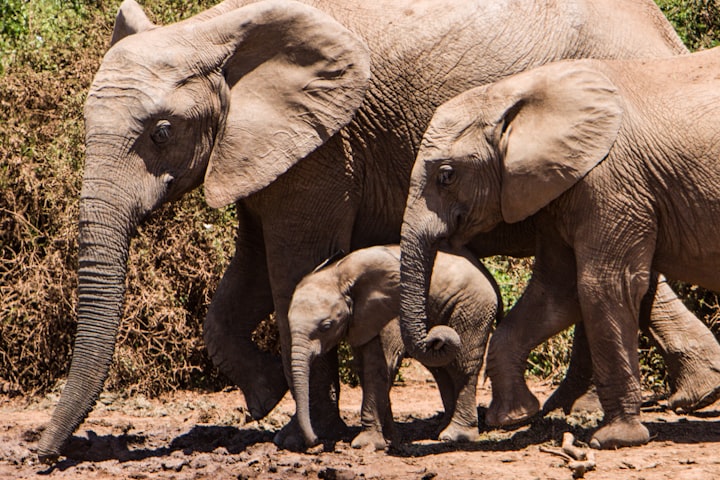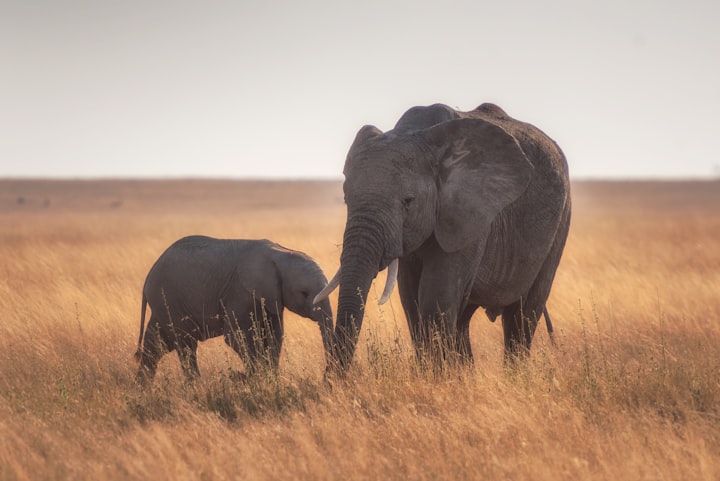Africa is so hot, how can elephants live?
Large theropods not only generate a lot of internal heat, but they have a relatively small surface area to volume ratio

Large thermostatic animals not only generate a lot of internal heat, their surface area to volume ratio is relatively small. When the weather is hot, an elephant emits more heat per unit surface area than a human to maintain a constant body temperature. The larger the elephant is, the more heat it needs to give off. Moreover, elephants do not sweat, nor do they pant like dogs. So, what is the elephant with the ability to "walk" in a hot environment?
One of the secrets of heat resistance is the large ears, which act as a large radiator, and a 1992 study showed that when the temperature was 20 degrees Celsius, a 2,000 kg African elephant could dissipate the excess heat just by flapping its ears. However, African elephants are weighing up to 7000 kg, and most live in an environment where the temperature is 40 ℃. At the same time, the size of the Asian elephant's ears is one-third of the African elephant, so they can only dissipate one-third of the heat through the ears. In this way, heat dissipation by the ears alone is far from enough.
Austrian Veterinary University's Wiesenberger research team also found another heat-resistant secret of elephants. They studied six African elephants at the Vienna Zoo. When the elephants opened their mouths, the tablets were thrown down their throats along with other delicacies. The "pill" is not wrapped in medicine, but temperature sensors and radio transmitters. Through the "pill", the researchers obtained a thermographic image of the elephant. Researchers found that when the elephant's head, ears, legs, and abdomen will appear in hot spots. When a part of the body is covered with the capillary network, a large number of "hot blood" to this place, so that the skin becomes hot, thus forming hot spots on the thermogram. In other words, the place where the hot spot appears is the heat sink of the body.
The skin of all mammals is like a heat sink, through which the animal can dissipate excess heat to regulate its body temperature. The elephant is the first mammal known to be able to open, close and fuse heat sinks. According to Wiesenberger, this allows elephants to precisely regulate their body temperature in weather with the right temperature. Elephants use this strategy when they feel comfortable and are not cold or hot. Some researchers have even inferred that elephants can cool an organ by dissipating heat from a particular piece of skin.
Mammals have hair on the body surface, the hair layer can make the skin surface maintain a thin layer of air, and this layer of air can reduce heat loss, with insulation. However, the elephant's hair is sparse and does not play this role. So, what is the role of the hard and vertical hair on the elephant's body?
Princeton University's Mayer Ward through the study of computer models found that the sparse hair of elephants is not insulated, but acts as a "heat sink" role. Elephant hair can improve the cooling effect by 20%! He believes that elephant hair is not a relic of evolution, and may have evolved to help elephants cool down their function.
However, despite all the cooling methods, when encountering extreme heat, elephants may still not have the means to dissipate the excess heat. So, elephants evolved another cooling strategy. Wiesenberger also let Germany and Thailand's 17 Asian elephants swallowed "pills", using temperature sensors to monitor the elephant's body core temperature. Experiments show that in Germany when the temperature is 21 ℃, the elephant's body core temperature fluctuations in the range of about 0.5 ℃. However, in Thailand, when the temperature was 30°C, the elephant's body core temperature fluctuated by more than 1°C, from a minimum of 35.5°C at night to 38°C during the day!
Asian elephants by lowering their body temperature at night, thereby improving their ability to withstand the heat of the day
This is like a power outage in the summer, as long as the refrigerator with the right amount of ice, the daytime temperature is high, and the food in the refrigerator will not spoil because the refrigerator temperature rises too quickly. This ability was once thought to be the preserve of desert mammals, for example, the body temperature of a camel can rise from 34°C at night to over 41°C during the day!
As global warming increases, the tropical areas where African elephants operate will become even hotter. As global warming increases, the tropical areas where African elephants operate will become hotter. These areas will experience a greater increase in temperature at night than during the day, which will make it more difficult for large animals like the African elephant to maintain a suitable body temperature, and the elephant's survival prospects will be worrisome. Scientists predict that in the environment "forced" under the African elephant will certainly change some behavior patterns, and the body will also be the corresponding changes. Perhaps, the African elephant will eventually have to "thin" to adapt to the increasingly hot environment.
About the Creator
Flagler Danzig
The talent is 1% inspiration adds on 99% sweat, certainly, does not have that 1% inspiration, in the world all sweat to put or bring together also only is the sweat!






Comments
There are no comments for this story
Be the first to respond and start the conversation.